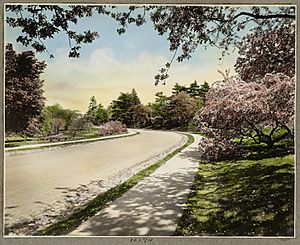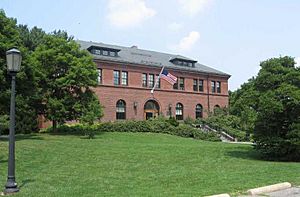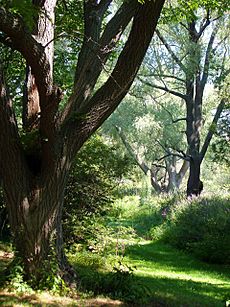Arnold Arboretum facts for kids
Quick facts for kids Arnold Arboretum |
|
|---|---|
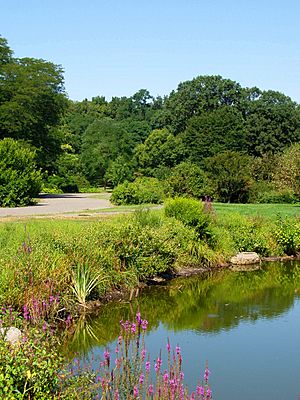
One of the small ponds within Arnold Arboretum
|
|
| Lua error in Module:Location_map at line 420: attempt to index field 'wikibase' (a nil value). | |
| Type | Botanical garden |
| Location | Boston, Massachusetts, U.S. |
| Area | 281 acres (114 ha) |
| Operated by | Harvard University |
| Status | Open year round |
|
Arnold Arboretum
|
|
| Built | 1872 |
| Architect | Frederick Law Olmsted |
| NRHP reference No. | 66000127 |
| Significant dates | |
| Added to NRHP | October 15, 1966 |
| Designated NHL | January 12, 1965 |
The Arnold Arboretum is a special place in Boston where scientists study plants. It's also a free public park for everyone to enjoy! It works with Harvard University and is located in the Jamaica Plain and Roslindale areas.
This arboretum, which is like a living museum of trees, was started in 1872. It is the oldest public arboretum in North America. Famous landscape designers, Charles Sprague Sargent and Frederick Law Olmsted, helped create its beautiful look. The Arnold Arboretum has a huge collection of trees, shrubs, and vines from places like eastern North America and eastern Asia. Scientists here study these plants and even go on trips to find new ones.
Contents
A Look at History
The Arnold Arboretum began in 1872 thanks to gifts of land and money. Benjamin Bussey and James Arnold were key people who helped start it. Harvard University chose Charles Sprague Sargent to be its first director. He worked with Frederick Law Olmsted to design the park. A special agreement with the City of Boston made sure the public could always visit for 1,000 years!
In the late 1800s and early 1900s, the Arboretum became a major center for plant research. Sargent wrote important books about North American trees. Inspired by trips to Japan, the Arboretum started collecting plants from East Asia. Botanists like Ernest Henry Wilson led these exciting plant-finding journeys.
During tough times like the Great Depression and World War II, the Arboretum focused on keeping its landscape beautiful. It also worked on teaching people about plants. In the mid-1900s, new ways to grow plants were developed. The Dana Greenhouses were built in 1962 to help with this research.
Plant exploration trips started again in the 1970s, especially in China. In 2011, the Weld Hill Research Building opened, giving scientists a modern place to study. Even during the COVID-19 pandemic, the Arboretum stayed open. It was a safe outdoor space for people to relax.
In 2022, the Arboretum celebrated its 150th birthday! It continues to be a top place for plant science, conservation, and free public enjoyment.
Where to Find It
The Arboretum covers 281 acres, which is about 213 football fields! It's located in the Jamaica Plain and Roslindale parts of Boston. You can find the Visitor Center at the Hunnewell Administration Building. The Arboretum has four main hills: Bussey Hill, Peters Hill, Hemlock Hill, and Weld Hill. Peters Hill is the tallest, standing at 240 feet (73 meters) high.
Local Weather
The Arboretum is in a climate zone where winter temperatures usually range from 0 to -5 degrees Fahrenheit (-18 to -21 degrees Celsius). This helps them choose which plants will grow best there.
Plant Collections
The Arnold Arboretum has more than 17,000 plants! These include about 10,000 different types, mostly focusing on woody plants from North America and East Asia. Many of these plants were brought here by famous plant explorers like Charles Sprague Sargent and Ernest Henry Wilson. More recently, new plants have come from trips to China, Taiwan, Japan, and Korea.
Some of the main plant groups you'll find here are maples, beeches, hickories, forsythias, pines, magnolias, oaks, rhododendrons, lilacs, and hemlocks. They also have special collections, like the beautiful Larz Anderson Bonsai Collection. About 500 new plants are added to the collection every year.
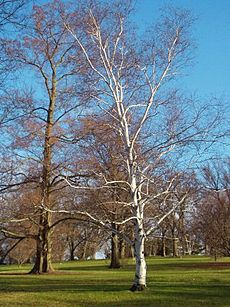
Keeping Track of Plants
The Arboretum uses a special computer system called BG-BASE to keep records of all its plants. This system helps them know where each plant came from, its scientific name, and where it's located in the park. They also use mapping software (GIS) to manage and display plant information. Each plant has a label with its unique number, name, and other important details.
Greenhouses and Nursery
The Dana Greenhouses, built in 1962, are where many plants are grown and cared for. You can also see the amazing Larz Anderson Bonsai Collection here from April to October. Bonsai are miniature trees grown in pots, and they are truly a work of art!
Other Collections
The Arboretum also has a collection of dried plant specimens, called a herbarium. These specimens are used for scientific study. The main parts of the herbarium and a large library are kept at Harvard University in Cambridge. However, a smaller collection of these items is in the Hunnewell building at the Arboretum.
Fun Activities
Plant Research
The Arboretum helps students and scientists learn more about plants. They offer special programs and awards for college students and researchers. For example, the DaRin Butz Foundation Research Internship Program gives college students hands-on experience. The Arboretum's library and archives are also great places for botanical studies.
Learning About Nature
The Arboretum has many programs for students, teachers, and the public. School groups can take guided tours. There's even a summer science program for middle schoolers! Teachers can get training on how to use outdoor spaces for learning. For families, there are programs that encourage exploring nature. Adults can enjoy talks, workshops, and tours about plant science.
Caring for the Plants
A team of experts, including horticulturists (plant specialists) and arborists (tree specialists), takes care of the Arboretum's grounds. They use modern equipment to keep the plants healthy and the park beautiful for everyone.
Lilac Sunday Celebration
Every year, on the second Sunday in May, the Arboretum celebrates "Lilac Sunday." It's a special day dedicated to the beautiful lilac flowers. People come from all over to picnic, take tours of the lilac collection, and enjoy activities for children and art programs. It's a very popular event, rain or shine!
Reading About Plants
Arnoldia is the Arboretum's magazine, published four times a year. It's all about trees and plants! It shares stories of plant explorers, new scientific discoveries, and the history of gardens. In 2022, the magazine got a new look and now includes poetry, art, and essays. You can even read old issues online.
Working with Others
The Arboretum works with many other plant organizations around the world. These groups include the American Public Gardens Association and Botanic Gardens Conservation International. They also team up with groups like the Center for Plant Conservation to help protect plants both in the U.S. and internationally.
See also
 In Spanish: Arnold Arboretum para niños
In Spanish: Arnold Arboretum para niños
- Larz Anderson Bonsai Collection, a famous collection of miniature trees
- List of botanical gardens in the United States
- List of National Historic Landmarks in Boston


